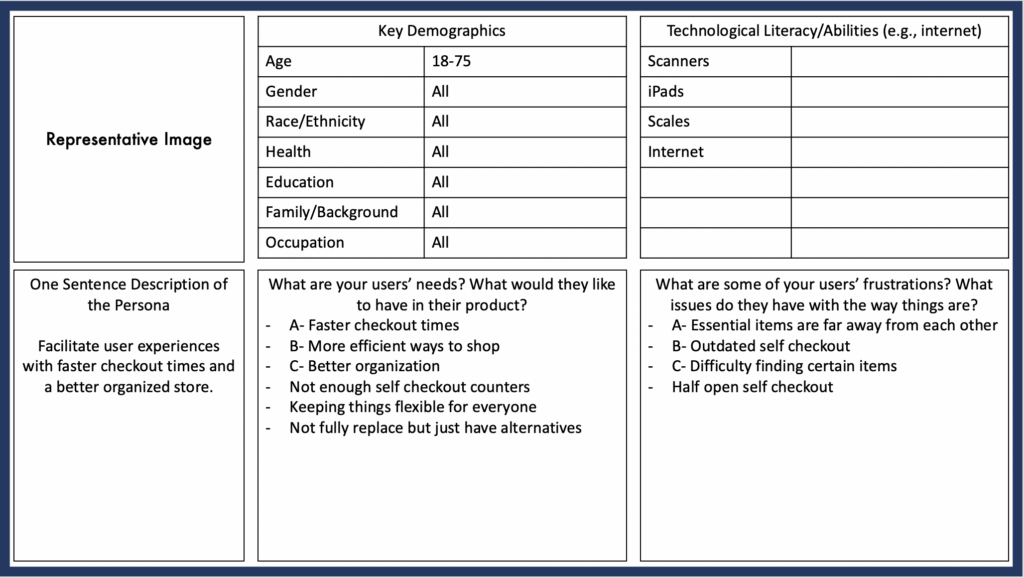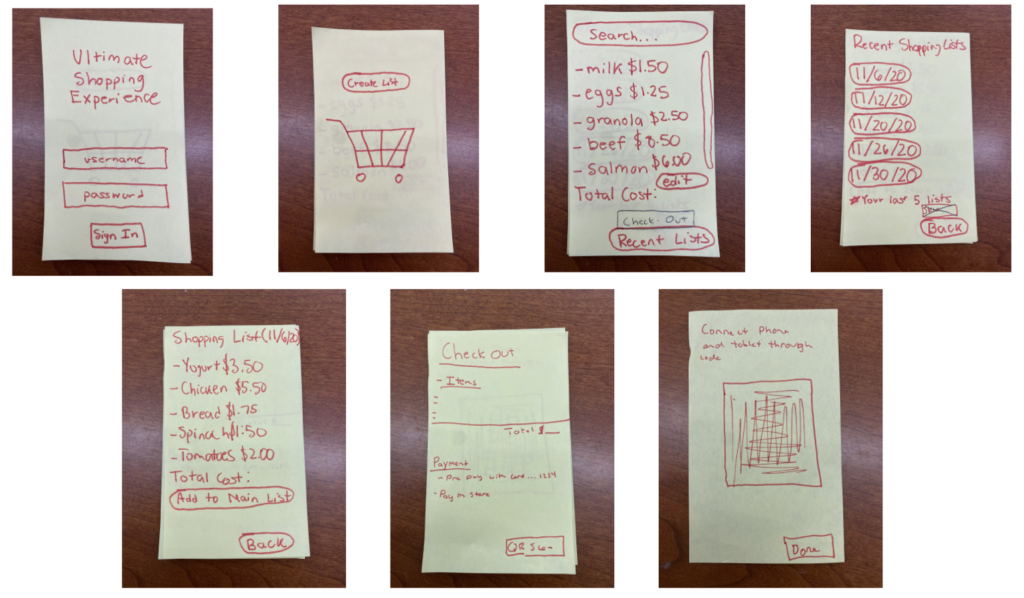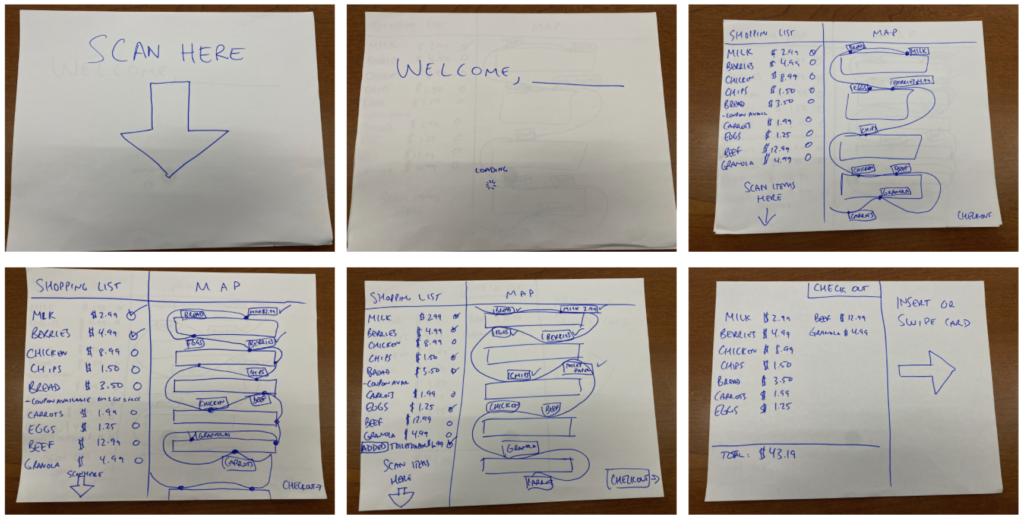Our Project
We were tasked with the goal of making the grocery shopping experience more efficient, while considering the needs of both the store owners and shoppers. We chose to design a smartphone app and a SmartCart, that allows you to predesign a shopping list to make your experience as fluid and efficient as possible. The design also gives you a GPS map of the store to present the most time-sensitive route for you to access all the items you need. This project achieves the goal of making the shopping experience more efficient and cost-effective, while also being attractive for store owners.
Our Team
Max Johnston
Justin Weiss
Dylan Siesky
Jack Dolan
What is the problem you chose to solve?
The problem that we chose to identify in making the grocery store experience better was making the entire experience more time efficient. Often times it is very frustrating to go to the grocery store. The lines are long and people can not find anything when shopping. We wanted to make this experience as seamless as possible. This was evidenced with our at home aspect of our prototype. This would allow users to create shopping lists at home and adding methods of payment so you can pay straight from your phone. We wanted to cut down the amount of time people were in the store. We wanted to address this by adding a feature that would allow users to see the most efficient routes around the store. We also added a feature so that guests could check themselves out in order to avoid long lines even at self-checkout.
How did we identify this problem?
We identified this problem by simply listening, observing, talking, and reflecting. Earlier in the semester we went the local Giant grocery store. We listened to peoples complaints when we had conversations with them and we watched people. We saw how long these lines got at things that were meant to lessen the time at the grocery store like self-checkout. We then thought about our own experiences. We noticed that as younger people we are always on the move and want to spend as little time as possible shopping. Using our own experiences and listening to others we were able to formulate our prototype.
Who did we Design for?
When analyzing the individuals that we observed in the grocery store in comparison with our own experiences, we were able to determine a specific population that we wanted to design for. We observed that there was a population of people that wanted their grocery store experience to be as efficient as possible, taking the least amount of time while also getting the items they desired. This population includes: employed individuals with busy schedules, students, parents, and other people with busy schedules. There is also a certain level of technological saavy necessary to operate our product, despite the simple nature. To be able to access the tablet on the cart it would also be necessary to have a smartphone, because the phone app is what starts the process.
One aspect of our design target that we didn’t fully expect going in but is clear now is the economic nature of our user group. Due to the cost of smartphones and the quality of grocery stores that would be able to adopt this product in its early stages, it is likely that our target group will be relatively economically successful. We chose to purposefully design for a specific population, because we believe our product is a direct solution for the issues with these peoples experiences.

Who are we NOT Designing for?
One of the issues with designing for a specific persona is that the people we end up not designing for is a relatively large sample. Given that we chose to design for people with technological experience and a desire to have a quick shopping experience, this eliminates people with little technological ability. It also eliminates people who enjoy the grocery shopping experience, which is a population that we discovered during our research. When asking family and friends we noticed that some people didn’t need their grocery shopping experience to be expedited. Our solution may make their shopping easier if they are easily forgetful, but given that efficiency was our primary concern we didn’t consider the specific desires of this population.
One issue that arose within our product was the accessibility for the disabled population. One solution that we found was to have a cart that was similar to a typical handicap shopping cart, with our smart features enabled. While this is a feasible solution, it is likely that our solution wouldn’t be especially effective for the disabled population. Our cart is designed for maximum efficiency for a specific population, and decisions for accessibility would likely come further down the line.
Final Solution
Our final solution is a combination of a smartphone app and a smart shopping cart, featuring a tablet and in-cart scale to measure the weight of items scanned. This solution attempts to achieve the goal of making the shopping process more efficient, and we believe that it accomplishes this goal based on the desires we gathered from shoppers we have interviewed and observed.
Below are images of our Smartphone App, which allows the user to craft a unique shopping list based on searches of a register of all food items, scans in store, and previous shopping experiences.

The first slide is a welcome slide, where you enter your specific username and password. You then go through the process of creating a shopping list, which can be done at any time from any location. Once your list is completed, a QR code will reveal itself, which is used to access the SmartCart. The QR code will be scanned on this tablet, and the process continues from there.

Once the QR code is scanned, it will grant access to the cart and begin the shopping process. It will provide you with a shopping list and map of the store, with a GPS route of the most efficient way to attain all of the desired goods. You scan the items on the tablet and place them in the cart, which has a scale to ensure that the correct items are scanned and purchased. When you are finished with the shopping process, you utilize the seamless payment options on the cart, skipping long checkout lines and finishing the checkout process as you go.
How did we arrive at our final solution?
As a group, our collaborative discussions and activities helped us to gain a better grasp on and advance toward our final solution. This proved to be very challenging for us. In relation to such difficult discussions through class activities, two activities were the main reason for our arrival at our final solution. A couple of class activities challenged us to come up with preliminary ideas as well as rank what the most important aspect of the grocery shopping experience was for us to design for. The conversations within the group that followed were difficult and important. They were extremely difficult in the sense that we were attempting to come up with the best possible solutions and recipients of our design. They were of major importance because they helped us arrive at our final solution.
We focused on the problems that we wanted to solve, like a slow checkout process and constantly forgetting items, and instead of trying to create a perfect overarching solution from the jump, we chose to solve each individual problem. We solved the slow checkout process by adding a checkout feature on the cart. We solved the issue of forgetting items by creating a shopping list to be shown on the cart. We solved the issue of grocery shopping being inefficient by developing a GPS mapping ability. It wasn’t until we found the best way to solve all our problems that we chose to combine these solutions into a final solution, which is how we ended up with the SmartCart.
How Do We Know This Solution Works?
We know that this solution works based on the tests we did. For the first round of testing our team allowed fellow students to become users. They gave us insight on how to make things simple. We simply did not want to overcomplicate our app. In the first round people were easily able to navigate our app with little difficulty or question. The next week we tested on senior design students. These students gave us some very professional insight on ways to improve our app. However, we were still able to measure that rate of success by seeing how easy these people were able to navigate their way through the prototypes. We were also able to verbally explain our solution to other members of our target audience, with positive impressions from those surveyed.
Of course, we won’t know for sure how the solution will be received when it is made mainstream, but due to the targeted nature of our solution the results we collected in class hold relevance for the subjects that will eventually be using our product. By designing for a specific group, our solution could be more focused on a certain group, which builds our confidence that our solution will work.
Teamwork
What did we do well together?
Our team was able to communicate which really distinguished us. All of us had very little experience with design, making this task a little daunting at first. Our team was able to successfully manage a way to stay productive simply by talking about our own ideas. From there we met at a common ground where each team member’s original idea was integrated into the design. For example, Max thought of the idea of having some type of shopping cart, Dylan thought of the idea to have a scanning process used by the user, Jack thought of the idea about adding technology to the experience, and Justin thought of the idea of making things more time efficient. Using a little bit of everyone’s idea we were able to create this meaningful prototype.
What challenges did we face?
Being that this is an introductory module in engineering, our minimal experience alone proved this design process to be challenging. We were pushed to collaborate, brainstorm, and discuss with one another to lengths many of us never have reached before. A larger challenge we faced was agreeing on a final design. Two main turning points come to mind in retrospect. We were tasked with coming up with as many answers as possible to questions such as who to design for, as well as pinpointing what to design for in terms of the most important problem of the grocery shopping experience. From these we recorded initial ideas and preliminary solutions on post-it notes, and sorted them based on similarities. It was the discussions following the sorting of the post-it notes that were of significant difficulty for us as a group, as we spent a lot of time attempting to come to an agreement on what would work best. We based our decision mainly in the context of our problem statement regarding time efficiency.
Both our challenges and successes were born out of our lack of experience with design, but the experience validated our ability to collaborate, communicate, and be flexible in the design process.
What Changes or Improvements could we make in the Future?
We feel that having been given feedback from a more experienced group earlier on in the design process would have been beneficial to a better solution. In our first round of testing, we were given feedback by classmates who have equal experience in engineering. A couple of weeks later, we conducted our second round of testing and feedback, this time to senior engineering students. Their feedback ended up being of major help to us, and we even talked about wishing to have heard from them earlier on. We agreed that this would have allowed us to have had a better sample of ideas to add to our solution over a greater period of time. We also agreed that in the future, our design process should be critiqued by an experienced or even semi-professional group of engineers.
In terms of our solution, the biggest area for improvement is accessibility. We struggled with finding the best way to include certain groups, eventually deciding that our design works best when targeted at a specific group. In the future, we would like to add options for a greater range of individuals to use our product. One aspect we have talked about is creating a SmartCart handicap cart or having an audio version for the visually impaired. There is certainly room for improvement and we hope to make our solution as accessible as possible in the future.